-- Posted Friday, 9 June 2006 | Digg This Article
THE VALUE VIEW GOLD REPORT
Moneyization: The global financial phenomenon of individuals and businesses moving their funds to monies in which they have the highest confidence, or money in which they have a higher store of faith.
Or, Raining on the Parade
Last Monday we watched rain, perhaps even some hail, fall on Wall Street's parade. For two decades the Street had relied on a friend at the Federal Reserve to keep the rain off them. The 20-year era of ever descending rates protecting the paper asset groupies is over, and that realization is shocking them. Around the world paper equity markets are being ravaged by selling from hedge funds as they withdraw back to hide under their rocks. As the first graph shows, the sunshine has been in the Gold market and the rain has been on the paper parade for more than eight years. Part of that magnificent return was produced by the "sunshine" of money from hedge fund and other funds. Now they are withdrawing, producing a little rain on our Gold parade. That will pass, and bull market to over US$1,300+ will resume!
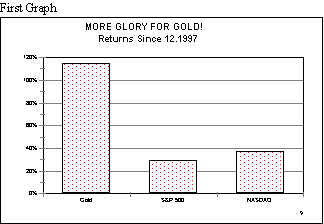
That first graph portrays the essence of the moneyization phenomenon. All around the world investors have been moving out of fiat money and paper assets into the one true global money, Gold. Wise investors were able to foresee the change in the investment climate years ago. The issue today is what the future holds, and that future is also bright for Gold. In Barron's article, "Last Laugh" by J. R. Lang, 5 June 2006, Jimmy Rogers's favorable outlook, past and present, is recounted. From the article,
"According to Rogers, new Fed Chairman Ben Bernanke is 'an amateur with no knowledge of markets' whose academic work revolved around how nations could avoid depression by printing more money"(p.19).
With a Federal Reserve Chairman willing to "print money and dump it from helicopters," Gold bugs have a fairly secure future. The Federal Reserve has not had an inflation hawk since Volcker, and he was only appointed cause conditions were in a near crisis stage. Until a crisis stage again returns, the monetary and fiscal policy of the United States will hurt the value of the dollar and help the value of Gold.
This morning CNBC is reporting that Wachovia had downgraded homebuilder stocks. Huh? Isn't this the company that just agreed to spend $26 billion buying a giant mortgage portfolio? Maybe the management of Wachovia does not talk to their analysts, just to their investment bankers. While the statistics are still spotty, South Florida's experience may be indicative of the success of buying a mortgage portfolio. In Palm Beach county, for example, the value of foreclosures has risen dramatically as shown in the second graph. Note that the report is on "pre-foreclosure value," which will likely be well above "realized value."
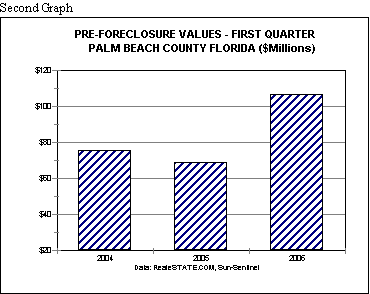
The data for that graph came from, "Risky loans come home to roost as foreclosures" by Pat Beall of The Palm Beach Post, 28 May 2006, p. 1A, 10A. In that same article we find an understatement, "'We know the whale is coming, we just don't how big the whale is'," said Mike Flagg, a spokesman for the Center for Responsible Lending, a Washington nonprofit that tracks lending practices." Though to really get a taste for the situation try Barron's "Second Homes: The Big Glut" by R. G. Blumenthal (29 May 2006),
"It would seem to have it all, four bedrooms, a guest house, a pool and a rock waterfall. But the vacation home in Naples, Fla., hasn't been drawing much interest from buyers, so the seller recently threw in that most modern of amenities: the $1 million price cut. That's brought the asking price down a full 25%"(p.21-23).
That article also provided data from The Local Market Monitor on the recent percentage of homes in some markets that have been purchased by speculators. The speculative buying has ranged from a low of 20% in Charleston SC to a high of 58% in Myrtle Beach SC. In Naples, cited in the quotation above, the percentage purchased by speculators is estimated at 45%.
So, how are the speculators doing? The following table will help to answer that question. A table is used because the appropriate descriptive answer to that question would not be allowed on most web sites. Perhaps an apt description would be that they are getting hammered.
U.S. HOUSING BUBBLE BURST TRACKER
in Nominal U.S. dollars.
April 2006 Data | Single Family | Condo |
Peak Price | Aug 2005 | Jun 2005 |
Price Change - Annualized | - 3% | - 3% |
Sales Change - Annualized | - 9% | - 5% |
Inventory For Sale | +35% | +61% |
Months of Inventory | 5.9 Mos. | 7.1 Mos. |
Speculator's 12 Mo. Total Return | -174% | -233% |
Data: Median Prices from NAR; Return assumes 5% down payment.
As you can see from this table, speculators are learning a painful lesson. Speculating in real estate on margin is even more dangerous than was the buying of technology stocks in 1999. Speculators using margin take the risk of being wiped out, and that is what is in process for many of them. Speculators that have bought condominiums now can expect to bleed for seven more months before being able to sell, on average. Some local markets are in far worse condition.
The mathematics of finance is why the pain is far from over for speculators in housing. Because of the "math," prices are in the process of only beginning a collapse that will ultimately exceed 50%, and last well into 2008. For example, suppose an individual could afford a $2,500 per month housing payment, principal and interest only. At a 5% rate and 30-year pay, this buyer could borrow $466,000. The buyer would go out and bid $518,000, with 10% equity, for a home. The price did not matter, only the monthly payment.
If mortgage rates rise to 7%, that same monthly payment will only allow a loan of $376,000. No matter how much either the buyer or selling thinks housing prices might rise, the new buyer can only bid $418,000 for the house. The math alone drives the price down 20%. And at this point no consideration is given to the ability of the borrower to make the payments, the ability of the existing owner/speculator to continue making existing payments, or forced sales by financial institutions of foreclosed property.
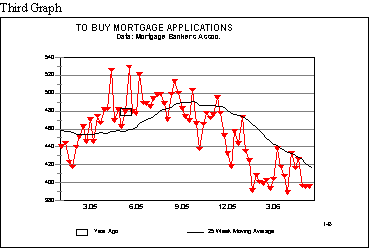
The lesson is simple, and little forecasting is involved. The "math" of mortgage financing is what pushed up housing prices. The "math" will be what pushes housing prices down. What has not been yet factored into this thinking is that buyers might not appear. As the third graph above shows, buyers are disappearing.
Again, why care about housing prices? Collapsing demand for housing means construction workers out of work, workers not making car payments, carpets that are not sold, and the closing of construction businesses. Financial institutions will be taking losses, laying of workers as they do. That brings us to the chamaeleon Chairman now in charge of the Federal Reserve.
Last week he was one thing, and this week Chairman Bernanke is an inflation fighter. The Federal Reserve will fight inflation right up to the point where the collapsing housing market starts to show up in the headline statistics. At that point, the Chairman's true stripes will be apparent. The FOMC will abandon their inflation fighting immediately and adopt policies that will only lead to further depreciation of the dollar. True question is not what the FOMC does in June of 2006 but what it will do in January of 2007 when the first major mortgage related defaults occur. And what happens if one of those mortgage market defaults is held by those gullible foreign investors? What will the dollar do then?
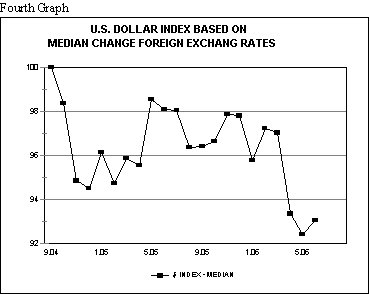
The U.S. dollar did get short-term oversold. Since then, many bearish bets have been reversed on the basis of the Federal Reserve "getting tough." However, the underlying negative trend has not been reversed. The dollar index that is popularly quoted and traded is a fairly useless measure, as we have written before. In the fourth graph is an index of the dollar's value based on nine major national moneys using the median change in exchange rates. This median measure is probably a better indication of trends. The recent bounce in the dollar's value is simply off a short-term over sold level, and does not suggest a true bottom or the start of a new trend. The bounce in the U.S. dollar is due to the reversal of bearish trades by hedge funds, and cessation of foreign businesses pre selling future dollar revenues.
As we write, the penguins on CNBC are cheering as Gold prices go lower. They are doing so with the same enthusiasm they did the day they believed the Dow Jones Industrial Average was going to 12000. Ignored is that the NASDAQ Composite has collapsed through critical support at 2180. Now they have determined that a critical bottom might be developing in the paper equity markets. They love the recent slide in the prices of Gold and Silver. Perhaps so should we, but for a different reason. The departure of hedge funds and other funds from Gold and Silver is creating a summer of repetitive buying opportunities.
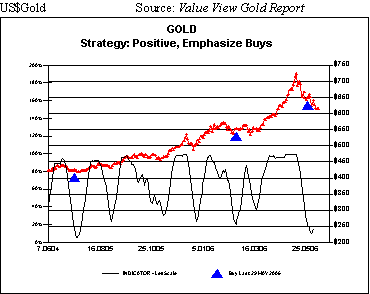
US$Gold, as shown in the above chart, is creating a buying opportunity with this summer's bargain prices. The departure of leveraged momentum money run by hedge and other funds has pushed prices down to levels that investors should consider attractive. The indicator has not been this over sold since the summer of 2005 when US$Gold was below US$450. At that time, as now, the "market strategists" on the Street were recommending the avoidance of Gold, and Silver.
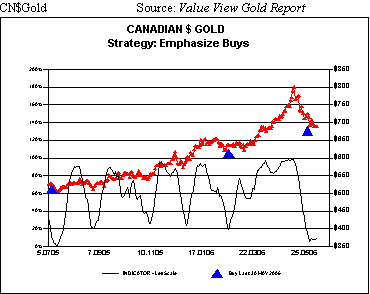
Last graph is of Canadian $Gold. In that graph is also shown an over sold condition not seen since last summer. The Canadian dollar has been used as a "commodity play." That action has pushed the exchange rate up to a level where Canadian investors should be taking some profits, an opportunity not often presented. While of course, the summer could continue choppy for CN$Gold. Canadian investors should be buying for tomorrow's profits.
Ned W. Schmidt,CFA,CEBS is publisher of THE VALUE VIEW GOLD REPORT and author of "$1,265 GOLD", published in 2003. A weekly message, TRADING THOUGHTS, is also available to electronic subscribers. You can obtain a copy of the last issue of THE VALUE VIEW GOLD REPORT at http://home.att.net/~nwschmidt/Send_Last_Report.html Ned welcomes your comments and questions, and tries to answer most all. His mission in life is to rescue investors from the abyss of financial assets and the coming collapse of the U.S. dollar. He can be contacted at nwschmidt@earthlink.net.
-- Posted Friday, 9 June 2006 | Digg This Article

